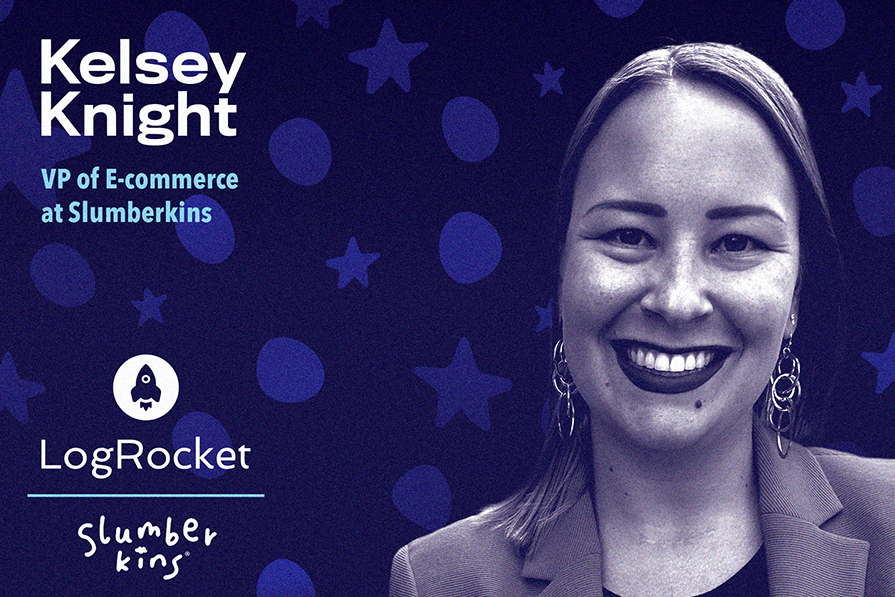Leader Spotlight: Efficiently scaling ecommerce operations, with Kelsey Knight – LogRocket Blog

Kelsey Knight is VP of Global Ecommerce at Slumberkins, a social emotional learning children’s brand. She began her career as a social media coordinator at Asset Marketing Services, LLC, where she ended her seven-year tenure as Director of Digital Marketing. Kelsey was recruited as the VP of Ecommerce for Balanced Nutritionals, a holding company for two brands in the health and nutrition space where she led the strategy for two gummy vitamin brands. Kelsey has also served in a fractional capacity, working with clients on their digital strategies, teams, and initiatives.
In our conversation, Kelsey talks about one of the most exciting, yet challenging, aspects of ecommerce: that no one strategy works every single time. She discusses ROI as a key to prioritization because everything draws back to it, as well as how she builds teams to maximize expertise in and around digital strategy.
The importance of understanding your KPIs
To start, could you provide an overview of Slumberkins for readers who may not be familiar with the company?
Slumberkins is a direct-to-consumer (DTC) brand that was founded nine years ago by a therapist and an educator. The founders were best friends and were both on maternity leave at the same time when they began developing our 15 core creatures. They then built emotional lessons and stories around them in the form of books paired with plush toys. Now, we offer plush, books, and affirmations as a three-part system to help kids learn to better identify, process, and communicate their emotions.
As part of our DTC strategy, we also sell on Amazon. We have a budding B2B business that makes our products available in boutique shops across the country. We’ve also recently started to venture into the Canadian market. Further, we have a growing education side of the business where we work with schools and teachers — they leverage our curriculum and tangible products to bring the lessons to life in their classrooms.
What are some of the strategies that you’ve found to be most effective for scaling ecommerce operations?
One of the most exciting, yet challenging, things about ecommerce is that no one strategy works every single time. We’ve been in an ever-changing landscape over the last few years where the winning strategy for any given channel has rapidly evolved. When you’re looking at scaling, instead of choosing a strategy and sticking to it, it’s more important to understand your KPIs and what you can afford while scaling.
Right now, it seems that most of the industry is focused on profitability and particularly in achieving first-order profitability. For me, the most effective approach has been truly understanding all of our order economics: cost of goods sold (COGS), ad spend, fulfillment, and handling, everything that goes into the cost of that first order, and what we can afford from the bottom line. After that, it’s been crucial to fiercely prioritize goals against that and tie projects back to those KPIs.
Could you share an example of a time when, using data, you were able to make a recommendation to pivot the strategy or implement something new?
I like to think of ecommerce in five core categories: acquisition, retention, conversion, product, and brand. Each of those categories has KPIs, teams, goals, and projects all tied back to them. For example, say we’re focused on acquisition and understanding our break-even customer acquisition cost. Our paid channels might have a really clear CPA target for that spend, but the way that our organic and retention channels layer into that to convert new user traffic has to come together. We want to create an ecosystem that works at the scale that we are currently at.
In the past, I’ve also looked at customer cohorts and understanding the consumer life cycle in terms of duration, time to second purchase, frequency, etc., before then pivoting to strategy.
Specifically, in a previous role, we found that it was taking a long time to get to the second order — over one year in a lot of cases. We wanted to shorten that to four months. So, we deployed a subscription service that would auto-deliver products every three months. This meant the second and third purchases were in place at the three-month mark automatically, as long as the users maintained their subscriptions.
‘Getting picky about your ROI’
What are some challenges that you’re facing in terms of macroeconomic factors?
COVID-19 systematically changed how and where consumers are shopping, what they’re spending their money on, and how often they’re spending. We’re now in an economy where other costs outside of consumer spending are changing too. For example, childcare costs are up 36 percent over the last decade. Student loan payments were in forbearance for a long time through the pandemic, but now people are in repayment. Interest rates are holding. Consumer credit card debt is up and personal savings are down. It’s a perfect storm of all the things that impact a household and make them feel the pinch.
This has created an interesting time for businesses because we’re facing similar rising costs and challenges. A lot of brands are scrambling to navigate this. As a consumer, you’ll see things like increasing prices to improve margins or heavy discounts to try and increase conversion and sales. Depending on what sector you look at, you might notice a trend in that direction. Many of the levers brands are pulling aren’t driving the results they’d expect to see because of the unprecedented economic environment.
How are you overcoming and navigating these challenges?
I don’t think there’s one clear answer to how to get through it. We’re all learning as we go and it varies by industry, audience, and product. I recommend understanding your costs and getting picky about your ROI on various efforts, projects, and channels. I’m surveying and listening to our customer base regularly so we can understand where they’re at and how we can meet them where they are — all without sacrificing the business.
Aside from that, it’s also important to be willing to revisit ideas that were put on the back burner before because they may have a unique time and place now. Be nimble and don’t be afraid to try things.
Do you find that over the past few years, consumer expectations have changed too? For example, maybe people now expect free shipping or other services that they may not have taken for granted before.
Yes, absolutely. Free shipping is at the top of that list. And two-day shipping has also been hard on the DTC channel. It’s the Amazon effect, and Amazon is a monster in the space — they can take on those costs in a way that smaller DTC brands may not be able to. That’s another area that we’re testing and learning.
For example, we’re part of a small group of brands that have started using Buy With Prime. It’s Amazon’s solution for DTC websites to fulfill orders through Amazon. Prime members take advantage of their Prime benefits through our regular ecommerce website, but we maintain ownership of that customer relationship and they experience our brand through DTC. The only difference is that Amazon is actually delivering the order — and, of course, we’re paying a fee to Amazon on those orders.
Understanding touch points within the ecosystem
You’ve talked a bit about the different channels and how they work together. Could you discuss your approach to integrating various digital marketing channels, like paid search, paid social, and email marketing, to create a seamless customer journey and maximize ROI?
It’s really important to understand what those touch points look like in your current ecosystem. We’ve all heard that it can take seven different touch points from when a user discovers your brand to when they convert. Understanding what happens throughout those seven touch points and how long that process takes is really critical in determining how you can influence it.
I like to do a customer journey audit once a year, at minimum, to understand where people are discovering us versus where they’re converting. If you do that, you can tailor your strategy to it.
For example, Meta ads drive a ton of our new user traffic, but we’re finding that when they get to the site, they sign up for email, hang out on our email list for a while, go through our welcome flow, and then eventually make their first conversion directly from email. For us, it’s critical to understand when a customer discovers us through a Meta ad (or anywhere else on the web), converts to email, and everything in between. That’s how we’re able to make changes that impact speed to second purchase and other important KPIs.
How do you determine which touch points to optimize first?
Everything comes back to ROI and what you expect the lift to be. Something my team is seeing come up often nowadays is Pinterest — customers land there anywhere from the discovery phase to mid-funnel. That’s a channel that we’re interested in exploring. We’re going to take an organic approach with it initially because we see it in our customer journey, but we don’t quite understand how that channel’s being used yet. This means we’ll take a lower risk, lower cost approach to see what kind of traffic we can drive from this channel before layering in a paid ad strategy.
Building a team of expertise
What do you find is the optimal team structure for an ecommerce business to achieve scalable success?
It depends on where your company ist in terms of scale. If you’re just starting out, your team is going to look very different than if you’re already a $20–50 million DTC brand. I’ve found that a combination of in-house agency and freelance or contracted support has worked well. Typically, on the agency side of things, we’ll see expertise in the paid channel area specifically. Agencies have specialists within each advertising channel as well as a lens to the industry as a whole. They also have knowledge of industries adjacent or not related to you at all, which provides a better idea of the current economic state across the board.
I like to lean on agencies when it comes to paid acquisition channels. That, in combination with a strong media buying and creative strategist team, can be very impactful.
On the flip side, I found that it’s key to keep customer-first areas in-house. Nobody understands the brand better than your internal team — they’re living and breathing the brand every single day. Retention channels like email and SMS, organic, social, any online communities, brand and creative, etc., are all stronger when built in-house and supplemented with freelancers and contractors.
Do you have any insights to share for hiring and retaining top talent?
COVID has evolved the hiring landscape and opened up both candidates and employers to global markets. More talent is out there than ever before, and more companies are available to take on that talent.
After you’ve found your talent, prioritizing a strong onboarding experience and building connections with your new team members is more critical than ever. I’m especially finding that to be true as Gen Z enters the workforce. That generation hasn’t known a world without advanced technology. Some have completed a portion of high school, college, and internships — all remotely. Integrating them into your team, and teaching them how to prioritize the development of soft skills like communication, critical thinking, leadership, adaptability, and teamwork is both important and challenging.
How do you prioritize allocating resources when you have multiple digital marketing initiatives?
In the digital space, it’s easy to get sidetracked by the next new shiny thing because everything is changing so rapidly. This is where the constant ROI assessment comes in. I typically like to take a quarterly strategic planning approach. At the end of the year, I set goals for the full year and high-level ideas with the senior leadership team. Every quarter, I like to do strategic planning with the key members of my team. We look at our goals for the year, evaluate if we’re on track, and determine what we need to do to make up ground if we’re not.
Outside of that strategic planning session comes a list of projects that we scope and prioritize. It’s a constant ROI assessment, and it requires me and my team to not be afraid to raise our hands and take a pause on something that we feel strongly about. Things are changing — sometimes we do need to adapt to the next new thing. We’re constantly evaluating that.
Looking into how consumer experiences are evolving
You describe yourself as being a lifelong learner. What are you currently focusing on to stay ahead in the rapidly evolving ecommerce landscape?
I consume any and all media that I can about ecommerce. My favorite way to do that is through podcasts. I listen to the DTC Podcast and I’m subscribed to too many email newsletters that are sent daily with an update of what’s going on in the industry. Right now, I have my eyes on AI. I’m also focused on profitability modeling and tracking.
We’re in a post-COVID world where the days of strong revenue growth without profitability have come and gone. Now, everybody is looking for a healthy, sustainable business to scale profitably. I’m constantly evaluating ways to do that and understanding how other brands are going about it.
This sounds like an age-old problem, but I’m also focused on how consumer experiences are evolving across all stages of the funnel. We’re getting new channels and tactics all the time. We’re finding new creative assets and methods that work well. Staying on top of trends, investigating what others are seeing, and then testing those tactics within our own brand is a big focus of mine.
LogRocket generates product insights that lead to meaningful action
LogRocket identifies friction points in the user experience so you can make informed decisions about product and design changes that must happen to hit your goals.
With LogRocket, you can understand the scope of the issues affecting your product and prioritize the changes that need to be made. LogRocket simplifies workflows by allowing Engineering, Product, UX, and Design teams to work from the same data as you, eliminating any confusion about what needs to be done.
Get your teams on the same page — try LogRocket today.




